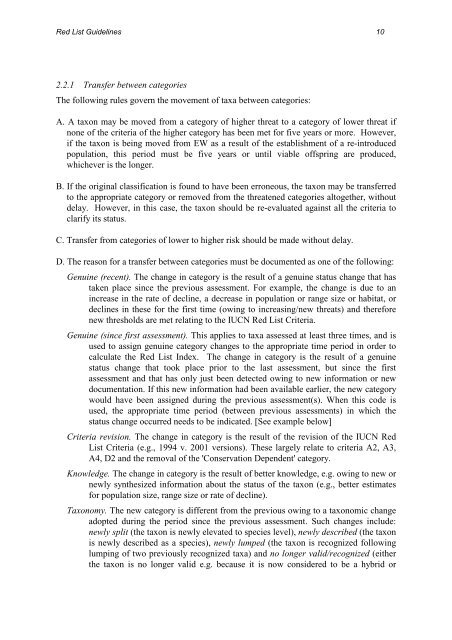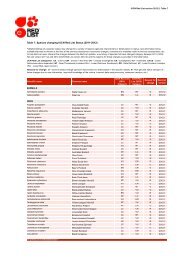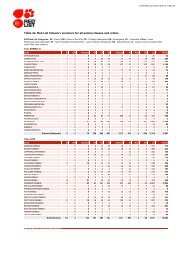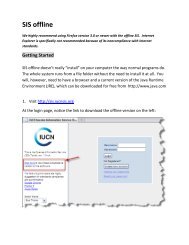IUCN Red List Guidelines - The IUCN Red List of Threatened Species
IUCN Red List Guidelines - The IUCN Red List of Threatened Species
IUCN Red List Guidelines - The IUCN Red List of Threatened Species
You also want an ePaper? Increase the reach of your titles
YUMPU automatically turns print PDFs into web optimized ePapers that Google loves.
<strong>Red</strong> <strong>List</strong> <strong>Guidelines</strong> 10<br />
2.2.1 Transfer between categories<br />
<strong>The</strong> following rules govern the movement <strong>of</strong> taxa between categories:<br />
A. A taxon may be moved from a category <strong>of</strong> higher threat to a category <strong>of</strong> lower threat if<br />
none <strong>of</strong> the criteria <strong>of</strong> the higher category has been met for five years or more. However,<br />
if the taxon is being moved from EW as a result <strong>of</strong> the establishment <strong>of</strong> a re-introduced<br />
population, this period must be five years or until viable <strong>of</strong>fspring are produced,<br />
whichever is the longer.<br />
B. If the original classification is found to have been erroneous, the taxon may be transferred<br />
to the appropriate category or removed from the threatened categories altogether, without<br />
delay. However, in this case, the taxon should be re-evaluated against all the criteria to<br />
clarify its status.<br />
C. Transfer from categories <strong>of</strong> lower to higher risk should be made without delay.<br />
D. <strong>The</strong> reason for a transfer between categories must be documented as one <strong>of</strong> the following:<br />
Genuine (recent). <strong>The</strong> change in category is the result <strong>of</strong> a genuine status change that has<br />
taken place since the previous assessment. For example, the change is due to an<br />
increase in the rate <strong>of</strong> decline, a decrease in population or range size or habitat, or<br />
declines in these for the first time (owing to increasing/new threats) and therefore<br />
new thresholds are met relating to the <strong>IUCN</strong> <strong>Red</strong> <strong>List</strong> Criteria.<br />
Genuine (since first assessment). This applies to taxa assessed at least three times, and is<br />
used to assign genuine category changes to the appropriate time period in order to<br />
calculate the <strong>Red</strong> <strong>List</strong> Index. <strong>The</strong> change in category is the result <strong>of</strong> a genuine<br />
status change that took place prior to the last assessment, but since the first<br />
assessment and that has only just been detected owing to new information or new<br />
documentation. If this new information had been available earlier, the new category<br />
would have been assigned during the previous assessment(s). When this code is<br />
used, the appropriate time period (between previous assessments) in which the<br />
status change occurred needs to be indicated. [See example below]<br />
Criteria revision. <strong>The</strong> change in category is the result <strong>of</strong> the revision <strong>of</strong> the <strong>IUCN</strong> <strong>Red</strong><br />
<strong>List</strong> Criteria (e.g., 1994 v. 2001 versions). <strong>The</strong>se largely relate to criteria A2, A3,<br />
A4, D2 and the removal <strong>of</strong> the 'Conservation Dependent' category.<br />
Knowledge. <strong>The</strong> change in category is the result <strong>of</strong> better knowledge, e.g. owing to new or<br />
newly synthesized information about the status <strong>of</strong> the taxon (e.g., better estimates<br />
for population size, range size or rate <strong>of</strong> decline).<br />
Taxonomy. <strong>The</strong> new category is different from the previous owing to a taxonomic change<br />
adopted during the period since the previous assessment. Such changes include:<br />
newly split (the taxon is newly elevated to species level), newly described (the taxon<br />
is newly described as a species), newly lumped (the taxon is recognized following<br />
lumping <strong>of</strong> two previously recognized taxa) and no longer valid/recognized (either<br />
the taxon is no longer valid e.g. because it is now considered to be a hybrid or






